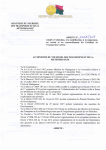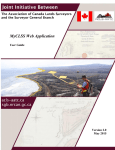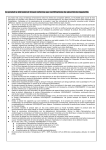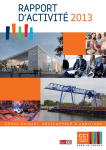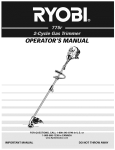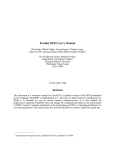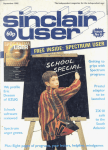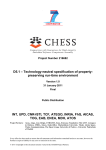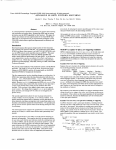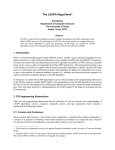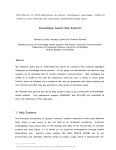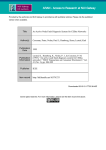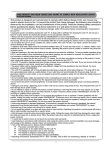Download REAL-OPS
Transcript
113
Proceedings of the 1986 Rochester Forth Conference
REAL-OPS
A Real-Time Engineering Applications Language
For Writing Expert Systems.
W. B. Dress
Instrumentation and Controls Division
Oak Ridge National Laboratory
Oak Ridge, Tennessee 37831
Abstract
This work describes how Forth was used as a descriptive language for
rewriting the expert-systems language OPSS. The goal was to produce a
multitasking applications language for real-world, intelligent control
problems. The next logical step--a derivative REAL-OPS running on a
high-speed Forth engine--is discussed. The resulting integration of Forth,
Forth engines, and expert-system technology in the mid-1980s will
the time-critical expert systems
provide the high penormance needed in
required for intelligent control of military and industrial systems now
planned for the mid-1990s.
Introduction
As the success of artificial intellgence applications became evident in the area of
expert systems for medical diagnostics1 and computer configuration2 problems, it was
just a matter of time until extending the methodology to problems of real-time process
control and data reduction was attempted. First attempts shoined clearly that execution
speed would be a limiting factor for any real-world control problem, so attention was
given to making LISP machines run faster and providing 1/0 channels with higher
bandwidth. One of the successes with a complex expert system digesting large amounts
of incoming data and providing expert decisions in realtime3 showed how effective such
an approach could be. .
However, the problems of efficient access to the inference engine and working data
left for
set by asynchronous external events were largely ignored, probably being
hardware manufacturers to $olve via the "bigger and faster" route. This seems an
unsatisfactory state of affairs in that only those institutions able to
afford the high-end,
newly developed LISP machines are able to consider applying real-time expert systems
to their problems.
Research penormed at Oak Ridge National Laboratory, operated by Martin Marietta
Energy Systems, Inc., for the U.S. Department of Energy under Contract No. DE-ACOS-
840R21400.
114
The Journalof Forth Application and Research Volume 4 Number 2
REAL-OPS is an attempt to fill the gap between merely running a system faster
necessary
(waiting until the
data
are present at an I/O port) and the asynchronous,
multitasking operation of a real-time, event-driven system. The idea is to start with an
effective real-time, multitasking software base and build into it the necessary expert
system capabilities in a manner recognizable to both the expert system and real-time
control communities. To this end, a multitasking version of Forth4 containing the
necessary interface words to the IEEE-488 instrument bus was chosen for the Hewlett-
the problems real-time,
Packard Series 200 and 300 desktop computers. Thus
multitasking, and access to external events were neatly solved, leaving the problem of
integrating an established expert"system language with an underlying Forth base.
The expert
systems language chosen for embedding in Forth was OPS5, a widely
used production-rule language. The reasons for this choice were twofold: first, OPS5 is
a powerful, forward-chaining, efficient language; second, it is conceptually and
syntactically simple. The first property gives the means to produce a language for
engineering control applications since such problems are usually event-driven; that is,
the expert controller must respond quickly and correctly to the instantaneous data stream
that conveys the current state of the system being controlled. The second property
allows easy extensions and modifications to the language, producing a more powerful
result tailored to the needs of real-time, multitasking expert systems.
What Is OPS5?
Cosmetically, OPS5 is a scheme for constructing production rules (modules) in the
form of IF...THEN.. statements. where the IF part, or left-hand side (LHS), specifies a
set of data patterns which must be consistently matched by a portion of the actual data
set residing in "working memory;" and the THEN part, or right-hand side (RHS), indicates
the set of
actions to be carried out when the LHS is
satisfied. Typically, the RHS actions
make or remove data elements in working memory, initiate I/O with the operator
or files,
and perform necessary calculations via external calls. OPS5, developed at Carnegie-
Mellon UniversityS in the late 1970s, is one of the mosttopular and widely used
one with a textbook devoted to it. Typically,
production-rule languages, and the only
OPS5 is used for writing
expert systems; but, being, conceptually and syntactically
it has much broader applications. The Brownston book6 devotes careful
simple,
attention to deciding when an algorithmic approach should be used for a problem and
when a production-system approach is more appropriate. Structure and complexity are
the
guide:
unstructured, complex problems are more amenable to solution
via a
production paradigm whereas well structured, simple problems are better handled by
specific algorithms. That is not tosay an expert-system implementation cannot represent
a well-structured problem. The often-cited "animals" expert system is usually expressed
as a set of backward-chaining rules that form a static,
almost algorithmic, decision-tree
involving complex, dynamic data patterns
would be difficult to represent in such a fashion.
Each OPS5 .rule is an independent module,
loosely coupled to other rules by the
type system. A truly unstructured problem
data set in working memory. There are no global variables in standard OPS5; all
variables refer to values of working memory elements, and the particular binding is valid
only within the rule where it appears. Conceptually, the set of rules in an OPS5 system
may be thought of as "peering" into working memory in parallel, each one "looking" for a
Proceedings of the 1986 Rochester Forth Conference
115
particular set of data patterns. When a rule finds a set of data patterns matching its own
pattern prescriptions (condition elements), it is free to "fire." . .
Internally, OPS5 is much more complicated than a set.of IF...THEN... procedures.
To see that this must be so, consider an expert system with one thousand rules, eacn
rule having ten conditions and each condition consisting of a ten-element pattern. The
brute-force method would be to consider each of the hundred thousand possible pattern
elements as a candidate for each data instance in working memory during each system
cycle, and then decide which rule to fire. Since there may be several thousand working
ten terms, even an efficient Forth system would
memory elements, each with perhaps
take too long to check all of the several billion possible matches to make a real-time
expert system feasible. The Rete algorithm7 is responsible for OPS5's efficiency. This
algorithm maintains lists of pointers from those actions potentially making working
memory elements that .c match particular condition elements to those same
condition elements. The current state of the system is maintained, and only differences
from the current state are noted during each pass through the "recognize-act" cycle. This
differential method obviates the need for matching each data-element term against
each
condition-element term during each system cycle.
Rules, Condition Elements, and Actions. A rule in OPS5 consists of a
collection of patterns, or condition elements, specifying particular instances of a class
object being considered, followed by a list of actions to be effected if working memory
elements consistently satisfying the patterns are present. Working memory is simply a
large memory pool or common area where instances of data patterns
are kept as long as
needed. The class object, or "literalized" object as it is usually called, is merely the name
of an n-tuple of attribute-value pairs, or "terms." As an example, consider a generalized
"vector" which has been given the class name of GOAL. Each term of this vector has a
name--its attribute. Thus a condition element such as (GOAL /lSTATUS READY /lID 101)
has two terms specified by the attribute STATUS and ID (/\ is a symbol indicating an
attribute similar to the way an element of a record is selected in Pascal). These
attributes, or slots in the n-tuple named GOAL, have values READY and 101 respectively.
The condition element specifies a pattern to be matched. Working memory contains the
actual patterns made by the system's rules, the operator, and, in the case of REAL-OPS,
by external events via event-handling tasks. Thus a working memory element such as
(GOAL /lSTATUS PENDING /lID 101) would not match the above condition element,
whereas the working memory element (GOAL /lSTATUS READY /lID 101 /lSUBGOAL 11)
consisting of just that condition element for itsLHS would be able to
difference between memory and condition elements is that the former are
would match.. A rule
fire. The
instantiated pieces
of data, while the latter are potential patterns to be matched; that is,
types of things the rules are "looking for."
The RHS of a rule consists of a set of actións to be carried out when the rule fires.
Typical actions include WRITE for messages to the console, BIND for assigning a value to
the specific
a variable, MAKE for making new working memory elements, REMOVE for removing
working memory elements no longer needed, and MODIFY, which is a combination of
MAKE and REMOVE. The actions that alter the contents of working memory are
responsible for driving the production system toward its goal of solving the particular
problem. In an event-driven system, MAKE must be altered to allow external events to
enter the expert system's data set in an asynchronous manner.
116
The Journal of Forth Application and Research Volume 4 Number 2
Of course, in a Forth-based system, one of the actions is FORTH, which takes as its
arguments any string of symbols acceptable to Forth's interpreter. This allows access to
previously written code as well as shortcuts in data manipulation and file access. Adding
enhancements is
also
be done by FORTH actions.
graphics and other
Writing OPS5 in Forth
The task of writing OPS5in Forth is organized into several "chapters" as
recommended by Brodie.8 The first few chapters deal with the necessary tools and
establish a hierarchical vocabulary structure. The tools chapter contains the words used
as bit manipulation, memory
throughout the entire application for such things
list bookkeeping. Since OPS5 requires a
management for dynamic data structures, and
multitude of dynamic lists (for pointers, data values, stacks, etc.) as well as the ability to
,
.
.
,
.
.
.
.
.
,
.
.
,
.
,
,
¡
I
\
\
,
,
\
\\
\\
Rete .
Network
,
,
,
\'\ \
\.
.
.
.
.
,
,
,
,
\
,
,
,
.,
Data
Patterns
.
\,." _ _ _ _ ~~ap _ ~~"'o!~ !v-i~a_g!': _ _"
~::::~~~T"~~.:7
Figure
1. Conceptual diagram of REAL-OPS showing main data and control flows.
Proceedings of the 1986
117
Rochester Fort Conference
elements, efficient memory management is essential
make and remove working memory
to Forth implementation. Most LISP and C implementations of OPS5 practice the
standard method of
as unneeded and
garbage collection9 by marking list nodes
deferring memory reclamation until absolutely necessary. The entire expert system must
then be put in standby mode while the memory is cleansed of unused data structures.
mode of garbage
An alternate method, adopted in this work,10 employs a synchronous
collection, avoiding the unpredictable, deadly delays of the conventional method.
Vocabularies are principally used asa logical convenience, mirroring the structure
in
needed to implement the OPS5 language. For example, the word MAKE appears
three different vocabularies--one for compilng the MAKE action into an efficient data
and making a new working memory
structure, one for actually carrying out the action
to
element when a rule fires, and one in the top-level vocabulary to allow the operator
MAKE things as welL. All rules are placed into a Production Vocabulary and all literalized
objects into a Class Vocabulary for convenience in categorizing for searches and user
access.
Figure 1 provides a conceptual overview of OPS5 embedded in Forth. Three
entities are external to the system--an expert system user, a Forth programmer and user,
and any number of external asynchronous events. Since Forth provides what is usually
referred to as the operating system, all communication actually takes place either via
Forth's interpreter orby means of drivers written to handle external events. The memory
partition common to OPS5 is shown with the major flow of control. Certain pieces are
located in the heap memory partition. while other sections are found in the usual Forth
vocabularies. The structures located in the heap have pointer references in the various
system words, making everything accessible from Forth words.
The Parser. The next REAL-OPS chapter contains the parser, which is
implemented as a transition network and makes extensive use of the DOER-MAKE
construct8 for vectoring various words into the parser framework. A special state stack is
maintained in the heap, allowing parser states to be nested. For example, when parsing
a condition element, the initial state is one expecting a class name. Once the user (or file
system) responds with a valid class name, the parser state changes to one expecting a
pattern term via the phrase STATE TERM.STATE, which switches the parser state to that
expecting an attribute-value pair and pushes a reference to 'TERM.STATEonto the state
stack. TERM.STATE in turn switches to VALUE.STATE upon entry of a correct attribute of
the class being considered. The word PRIOR.STATE is executed when the pattern for
merely pops the state stack and
the value of the slot being compiled is entered. This
executes the word pointed to by the new top stack element. (switching back to
TERM.STATE in this case). PRIOR.STATE is itself vectored from within a word called
END, which is executed after each symbol is entered by the user, effectively maintaining
the state stack at its correct level for parsing any legal phrase in the OPS5 syntax.
LHS and RHS Compilers. The next. implementation chapter contains the
mechanism for building the data structures representing production rules and compiling
the condition elements
into data structures accessible to the rules. Similarly, the
mechanisms for building the RHS actions into the rules are collected into a separate
from each class object to the condition
chapter. Pointers are maintained in the heap
elements of that class, similar to establishing inheritance in Smalltalk objects. The Rete
network is built by matching each
new action to all previous condition elements, and
each new condition element to all previous actions as the rule set is being
compiled. If
The Journal of Fort Application and Research Volume4 Number 2
118
an action could conceivably produce a working memory element satisfying a condition
element, a pointer to that condition element is added to the
network list for the action.
Bit maps for the satisfied condition elements in a rule and the terms present in a
condition element are
maintained while the system operates. Logical comparisons of bit
maps speed the matching process and conflict resolution. Each rule also contains a
pointer to a list specifying the current state of working memory as viewed
from that rule.
RHS Actions. The heart of the system is the chapter' containing all the words for
effecting the RHS actions in a running system. The simple action of ma.king orrèmoving
Rworkingmemory element may affect every rule
in the system, soa means of matching
the potentialities pointed to by
the Rete network is needed. If anew working memory
element actually matches a rule's pattern, a consistency check needs to be made. A rule
waiting for a variablec:~ and another variablec:y~ where the value bound to c:y~ is
not to be greater than
be matched by all numerical
the value bound to c:X~ would
instances ofC:b and c:y~, but perhaps not consistently so (try c:b = 5 and c:y~ = 11).
Note that each LHS may consist of several condition elements (patterns) and that
each condition element may have many working memory elements independently (or
disjointly) matching it.' The set of possible matches is the power set, or product of the
sets of working memory elements associated with each condition element in the LHS.
This can easily become a very large set; it is not uncommon for a rule to have 25
condition elements, each with as many
as 50 working
memory elements. The power set
contains 5025 elements, an astronomical number indeed. It would be hopeless to
attempt to examine each member of the power set for consistency, so, following Forgy,7
and checked for partial consistency. Consistency is checked
its most recent working
and
memory
element.
Then the next condition element is examined, starting with its most recent working
memory element,
and so on. If the last condition element is reached and
shows
consistency forone of its matching working memory elements, the set is consistent, and
partial sets are constructed
starting with the first condition element
the rule is placed in the conflict set. Should any of the sets of working memory elements
become exhausted before the
rule can be declared consistent, the rule ¡snot yet ready to
fire and the process terminates. Pointers
elements
are kept with each
entirety each time the
into the lists
of matching working memory
rule so that the process does not need to be repeated in its
rule needs checking. Thus the problem is far
less than indicated by
of the power set.
the size
satisfied rules. Since only one
above culminates in a
rule may fire in each cycle, conflict resolution
applies one of several strategies to pick
the winner. Deciding on the winning rule
Conflict
set of
Resolution; The recognize-act cycle mentioned
involves sorting all rules in the conflict set (which is implemented as a list of rule pfa's) by
recency of the
working memory element satisfying the rule's
first condition elementuthe
rule with the most recent element wins (Means-End Analysis strategy). This sorting is
done by a combination of sorting routines: a standard
exchange sort for fewer
than four
rules, an insertion sort for four to fourteerrrules, and an iterative versionquicksort above
fourteen.11 (Consult ref. 5 or ref. 6 for a detailed description of the various strategies and
the reasons for choosing one over the other.) If more than one rule wins under the
strategy chosen, a random choice is made
to decide the one winner.
to the user for
controlling the OPS5 system, defining the class objects; and specifying the rules. The
spirit of Forth is
retained as much as possible
in that REAL-OPS is a fully interactive,
Top Level User Interface. The final chapter contains the interface
119
the 1986 Rochester Forth Conference
Proceedings of
at any
incrementally compilng version of OPS5. Rules and class objects may be added
time, the system may be run one or many cycles, and rules may be removed at wilL.
the top level, and the state of
Working memory elements may be made or removed from
the system may be examined via a set of commands for displaying working memory,
matches to condition elements,and the conflict set.
Multitaskingând Real Time. Up to this point, the project has been that of
rewriting OPS5 in Forth, being car'eful not to beinconsistenhvith multitasking' needs.
the needs of the real-time community, the
the goal of this work is to address
Since
and the interface to external events providèd. If an
necessary alterations must be made
event is expected,itis a simple matter to enter a wait loop, periodically examining an 1/0
port or a register for the presence of the event. This nice, calm situation obtrains only
the
the real world of process control and autonomous vehicles, for example. If
rarely in
Hopefully, the canned
the "expert" reason about it?
expert is not to remain eternally blind, so a way of getting asynchronous (unexpected)
event is not expected, how can
events recognized must be found.
S
D
E
R
Temporary Data Storage,
N
I
Mailboxes, or
S
v
o
E
R
R
S
S
Blackboard
E
F
F
E
C
T
EXPERT SYSTEM
TASK
o
R
S
Figure 2. Data flow to and from a real-tlme expen system.
Figure
2 illustrates a typical block diagram for an interrupt-driven expert system.
Sensors continuously provide data about the process or experiment being controlled.
The sensor data should provide redundant and multivariate information (one sensor
properties), perhaps covering different aspects of the same
measuring several different
process variable. For example, temperature information could be obtained from thermo-
120
The Journal of Forth Application and Research Volume 4 Number 2
couples, from radiation measurements in different parts of the spectrum, and from a
fit---optic device. The expert system would be
required to "fuse" the various data
into a
couistent picture about the temperature of the object.
The expert system may be required to take actions (other than MAKE and
REMOVE), changing the course of events in the external world. Sensor readings would
presumably change, causing the expert system to respond to the new information. The
traditional expert system "knows" where it is going at all times as it is receiving answers
to questions it is asking by design~ These answers fall into definite, planned categories
system conceived here can neither limit
("does the animal have feathers?"). Since the
nor know the range or patterns of data that might be presented to it by the real world,
external events. will alter the course of the patterns of rule firings in ways not forseen by
the programmer; events are ll synchronous with the recognize.act cycle. Rules should
then be robust enough to allow for this eventuality. In a process control problem, the
encoded expertise
could consist mainly of rules for deciding which control strategies to
apply and when the process is at critical points in the multidimensional phase space. A
set of goal-oriented rules would provide an overall optimization much as probing is done
in control theory.12
The next section describes a solution to the problem of communicating external
(asynchronous) events to the rules of the expert system. The solution is simple and uses
constructs consistent with OPS5 syntax and philosophy.
Using REAL-OPS
The problems of event access described above are recognized by the word
"asynchronous," which means the expert system is not "consciously" looking for events,
bwt it must respond to events nevertheless. The method of treating such data is to
be compared to a
provide special pathways13 into working memory. The method can
once-popular beach toy. The toy had a bucket mounted in a bistable configuration; filling
the bucket with sand or water eventually caused the bucket to tip over, spillng its
contents into a mechanism of wheels and other buckets. A bucket-defining word was
written allowing the programmer to create access pathways into the working memory of
REAL-OPS. A bucket looks much like an OPS condition element, but has an attached
access-oriented procedure that dumps
the contents into working memory when the
bucket is filled. Also, a message is sent over the network notifying all interested rules
when the working memory element has been made. The bucket vocabulary, shown in
Table 1, is typically used from within interrupt service routines or data-handling routines.
An integrated application using REAL-OPS should consist of three parts: the expert
system, the real-world interfaces (drivers), and the operator interface for control and
display. The combination of buckets and FORTH actions on the RHS of rules provides
ingress of data into the expert system's awareness as well as carrying out required
real-world actions. The ability to call Forth from rules also allows the expert system to
access files and databases, plot data in a graphics window, display system warnings
through both the graphics and sound mechanisms, and display menus for operator data
entry.
Desired explanations of the system's behavior and choices can similarly be
enhanced through the use of Forth words graphically displaying the interconnections
between rules and condition elements.
121
Proceedings ofthe 1986 Rochester Forth Conference
Word Example
Description
BUCKET BUCKET (METER "VALUE "ID "TYPE)
PUT (see below)
Creates a new bucket structure callèd METER,
allocating three slots identified as VALUE,
ID, and TYPE
Puts the
data element into the indicated slot and
filed
marks that slot as being
INTEGER INTEGER PUT METER "ID ,or
INTEGER 101 PUT METER "ID
Uses the top item on the parameter stack for a
PUT operation, identifying it as an integer. The
secnd method takes the data item from the in-line
code for the PUT expression
SYMBOL SYMBOL Volt PUT METER "TYPE
Converts thi¡ in-line symbol to a token for the PUT
operation. A parameter version operates as in the
INTEGER case
STRING
STRING "Meter out of service" PUT
METER "TYPE
Converts each symbol in the string into a token,
builds a vector in memory, and uses a reference
to the vector fòr the PUT operation. Also has a
parameter version as above
VECTOR VECTOR
PUT METER "VALUE
A reference to a vector is us.èd for the PUT
operation. There is also an in-line version as
above
Forces a dump of the METER contents into
demon that
dumps a full bucket
DUMP DUMP METER
working memory. This is also the
FLUSH
FLUSH METER "VALUE
FLUSH METER *
, or
Empties the indicated slot (or the entire structure
if *). Usèd to prevent DUMPing if critical data are
expected
Table 1. Glossary used by data-handling routines for communicating
asynchronous events to the expert system. .
Results with REAL-OPS. Real-time benchmarks are difficult
to find since each
application is different. Falling back on the standard benchmarks of conventional expert
systems written in OPS5, two come to mind as having broad appeal: "Towers of Hanoi"
and "Monkey and Bananas." "Towers" is a recursive OPS5 program consisting of two
rules plus a rule for initializing the towers with rings and one for
printing out the results.
When printing is inhibited (but the print rule is left in the system), REAL-OPS running on
a HP236 (8-MHz MC68000 cpu) runs a seven-tower problem in 25.75, while the
LISP-based OPS5 takes 2 min on the MicroVAX 11, 60 s on a VAX 11/780,
and 18.9 s on
Texas Instruments' Explorer.
So far, only the sections concerned with matching condition elements to working
memory elements and with managing the heap memory pool have .been rewritten in
68000 assembler code, leaving much room for speed improvement. The "Monkey"
122
The Journal of Forth Application and Research Volume 4 . Number 2
version of the one found in ref. 6, has 30 rules. It runs slightly
is comparable
to an optimized C version of OPS5 on the
for code
IBM PC. This, of course, provides a hint of where to find additional candidates
optimization.
A less flashy property of REAL-OPS is its adherence to the spirit of Forth: it is an
are incrementally compiled as they are entered from the
interactive language. Rules
console or from external files. There is no restriction (as there is in OPS5) that al class
objects must be defined before am rules may be entered. The only restriction (a very
problem, an enhanced
faster than VAX speeds and
that
Forth-.Ike on~) is
a class ml)st be defined
before it can be used in a rule. As
instead of FORGET) and
re-entered. Working memory elements may be entered and removed at will, and the
current state of the network and conflict set may be examined (all as in OPS5). In short,
mentioned above, .rules may be removed (type EXCISE
developing a program in REAL-OPS has much the same flavor of interactive
development as in Forth, much to the user's delight and productivity.
Still to come is a means to "snapshot" a set of rules and working memory in any
calls to Forth words on the LHS side of rules will greatly
evolution. Also, allowing
state of
enhance the performance of certain types of rules. Most OPS implementations allow
backward" by keeping up to 32 prior states on a list. This feature
"running the system
makes less sense in a real-time environment where external data might not obligingly
repeat itself,
but would
be of use in debugging, so it may be added in the future.
High-Speed Expert Systems
The main thrust of this paper is to show one way of attaining the goal of very high
execution speeds for àrtificial intelligence, particularly for expert systems, that most
recent of AI's applied successes. It has been shown here how Forth can be used to
rewrite a successful and popular expert systems language with a resulting improvement
in performance and flexibility, as well as extension to handling real-time data. This final
section will hint at a means for attaining perhaps a several-orders-of-magnitude
improvement in execution speed.
Ideal Forth Engine. From the
early days, Forth assumed that the ideal
stack-oriented, threaded-code engine was available, and it ran efficiently on this ideal
machine. The only trouble was that this engine had to be emulated in the assembly
language
of the actual processor being used.
Upon comparing instruction sets of
various processors with thoi:einstructions actually used to implement the Forth engine, it
was evident that Forth is an efficient utilizer of hardware resources (many machine
instructions and registers are never used by the Forth
have be~n made by a number of people
emulator). This observation must
because there are about a half-dozen
architectures providing either an efficient emulation of the Forth engine or actually
implementing a
two-stack, threaded~code processor.
At Oak Ridge National Laboratory we have been using the NC4000,14,15 a high-
speeo Forth engine developed by Novix, Inc. After making several stand-alone work
stations16 based on the Novix Beta
Board, we ran a number of benchmarks17 and
of ,interest (including a fast Fourier transform). The memory
manager and the list manipulation work mentioned above are operational on the Novix
ported several programs
engine, so a test of list management has been performed. The results are sensational
Proceedings of the 1986 Rochester Forth Conference
123
for being done without any optimization, and are presented in a paper by H. G. Arnold17
even now outclassed at doing what they do best,
namely, list manipulation. The next-generation LISP machines (epitomized by Texas
but show that the LISP machines are
to four times slower than
Instruments' MegaChip LISP Machine) will run OPS5 about two
a NC4000-based system.
group of Forth engine companies produces a 32-bit version running at
If the current
40 MHz (MegaChip's clock frequency), we won't have to tackle the astonishingly difficult
and sticky
problems of parallel processing for at least a few more yearsna serial
processor will be (and is!) capable of amazing feats if its natural
language is Forth.
Summary
Forth is indeed a language for writing other languages, and it does its job with
effciency of programming, a minimum of code volume, and ease of maintenance.
Extensions and modifications to the target language come naturally as needed. The
forward-chaining OPS5 provides excellent pattern-matching capabilities for use in an
event-driven expert system, and the extensions provided by Forth allow communication
to the system from external asynchronqus events. This feature is something new for
expert systems (even though it has been a bread-and-butter subject for years for many at
this conference).
major
More work needs to be done in REAL-OPS, but it is even now being used.18 The
new endeavor is to port REAL-OPS to the Novix or Metaforth engines. (There are
other Forth engines on the horizon, too.) The time is ripe for Forth-based artificial
is
here (REAL-OPS, EXPERT-2 to -5 and
intelligence applications:19 the software
more,20 Forth-based Prolog, object-oriented constructs, and so on). The hardware is
here, too. The future is exciting!
References
1. See, for example, the review artiçle by Bruce G. Buchanan, "Expert Systems:
Working Systems and the Research Literature," Expert Systems, Vol. 3, No. 1,
pp. 32-51, January 1986.
2. Judith Bachant and John McDermott, "R1 Revisited: Four Years in the Trenches," AI
Magazine, Vol. 5, No. 3, pp. 21-32, 1984.
3. Peter Hager, "NASA Says AI Systems Just Getting Off the Ground," Government
Computer News, p. 72, April
11, 1986.
4. Creative Solutions, Inc., Mult-FORTH Version 2.00 User's Manual, Rockville, Md.,
1984.
5. C. L. Forgy, "OPS5 Userís Manual," Technical Report, Carnegie-Mellon University,
Department of Computer Science, 1981.
6. Brownston et aL., Programming Expert Systems in OPS5, Addison-Wesley, Reading,
Mass., 1985.
7. Charles L. Forgy, "Rete: A Fast Algorithm for the Many Pattern/Many Object Pattern
Match Problem," Artificiallnte/lgence, Vol. 19, No. 1, 1982.
8. Leo Brodie, Thinking Forth, Prentice-Hall, Inc., Englewood Cliffs, N.J., 1984.
The Journal of Forth Application and Research Volume 4 Number 2
124
9. Donald E. Knuth, The Art of Computer Programming, 2nd Ed., Vol. 1, Fundamental
Algorithms, pp. 406-20, Addison-Wesley, Reading, Mass., 1973.
10. W. B. Dress, "A Forth Implementation of the Heap Data Structure for Memory
Management," The Journal of FORTH Application and Research, Lawrence P.
Forsley, Ed., Vol. 3, No. 3, pp. 39-49, 1986.
11. Donald E. Knuth, op. cit., Vol. 3, Sorting and Searching, Chapter 5.
12. O. L. R. Jacobs, "Introduction to adaptive control," Self- Tuning and Adaptive Control:
Theory and Applications, C. J. Harris and S. A. Billings, Eds., lEE Control
Engineering Series 15, Peter Peregrinus Ltd., London and New York, 1981.
13. W. B. Dress, "Communicating Asynchronous External Data to an Expert System,"
Proceedings, Eighteenth Southeastern Symposium on System Theory, IEEE
Computer Society, pp. 294-96, April 7-8, 1986.
14. Charles H. Moore and Robert W. Murphy, "Under the Hood of a Superchip: The
Novix Forth Engine," Proceedings, 1985 Rochester Forth Conference; The Journal
of FORTH Application and Research, Lawrence P. Forsley, Ed., Vol. 3, No. 2,
pp. 185-88, 1985.
15. Earle Jennings, "The Novix NC4000 Project," Computer Language, p. 37, October
1985.
16. R. K. Adams and T. L. Bowers, "Making Novix Beta Boards into Development
Workstations," this proceedings, 1986.
17. H. G. Arnold, "Symbolic Processing Potential of Forth-Based Microcomputers," this
proceedings, 1986.
18. James Rash, "A Prototype Expert System in OPS5 for Data Error Detection," this
proceedings, 1986.
19. See the many papers in this conference proceedings dealing with highperformance hardware architectures and AI-oriented software.
20. Jack Park, "Toward the Development of a Real-Time Expert System," this
proceedings, 1986.












